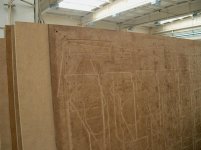Bite the bullet once and be done with it. Get a big enough plate of aluminum and mill it out. Thicker is better if going wider. I like to groove mine out with a 5x5 mm deep groove and for a plate the size you need I would go with a grid about 1.25" on center. In the center of each square tap a hole for holding stuff down. Countersink hole so a dummy screw can sit flush and keep chips out when not using that hole. Edge drill this plate in a few places as deep as you can. You can edge drill CL on groove or square, if on square then plan on a shallow X groove on square top. Drill and tap entrance holes to the edge drill so you can seal the unused holes. I use a .25 x .75 counter bore on these holes and put a punched out piece of 3/16 felt in the cbore as an intake filter.
Air powered venturis work fine and as David said, get a bit weak when passing coolant (so do I). Larger venturis consume more air and are less affected.
Once you know your part you make riser plates to elevate your work piece. These plates will be made to bolt down to the mother plate and have their own gasket groove on top. In many cases they are sacrificial too.
So, start with faced plate and add just the grooves that you need, but make sure they are on the grid. As you use this more and more you can keep adding to the grid as needed. Or git it all done at once.
I use .250 EPDM cord stock as it easily squishes down flat to the surface under vacuum. O ring cord stock has got to be put in perfectly for the same result. Other benefit with EPDM is that as it sits much higher above the surface it makes it a lot easier for the vacuum to seal, pulling the part down flat. On a piece as big as your making you will soon find out what that means.




